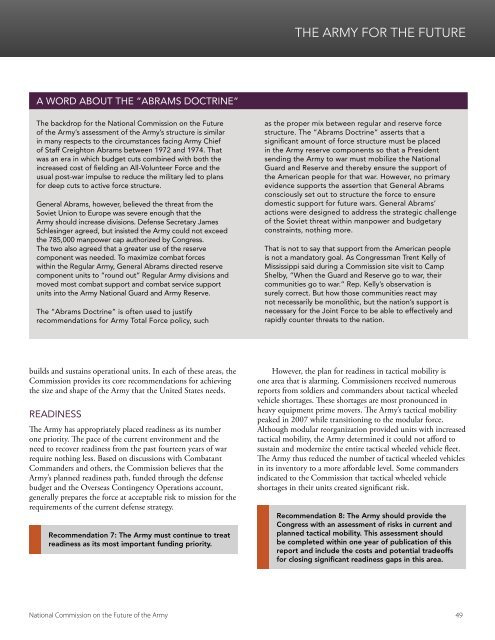THE FUTURE OF THE ARMY
NCFA_Full%20Final%20Report_0
NCFA_Full%20Final%20Report_0
Create successful ePaper yourself
Turn your PDF publications into a flip-book with our unique Google optimized e-Paper software.
<strong>THE</strong> <strong>ARMY</strong> FOR <strong>THE</strong> <strong>FUTURE</strong><br />
A WORD ABOUT <strong>THE</strong> “ABRAMS DOCTRINE”<br />
The backdrop for the National Commission on the Future<br />
of the Army’s assessment of the Army’s structure is similar<br />
in many respects to the circumstances facing Army Chief<br />
of Staff Creighton Abrams between 1972 and 1974. That<br />
was an era in which budget cuts combined with both the<br />
increased cost of fielding an All-Volunteer Force and the<br />
usual post-war impulse to reduce the military led to plans<br />
for deep cuts to active force structure.<br />
General Abrams, however, believed the threat from the<br />
Soviet Union to Europe was severe enough that the<br />
Army should increase divisions. Defense Secretary James<br />
Schlesinger agreed, but insisted the Army could not exceed<br />
the 785,000 manpower cap authorized by Congress.<br />
The two also agreed that a greater use of the reserve<br />
component was needed. To maximize combat forces<br />
within the Regular Army, General Abrams directed reserve<br />
component units to “round out” Regular Army divisions and<br />
moved most combat support and combat service support<br />
units into the Army National Guard and Army Reserve.<br />
The “Abrams Doctrine” is often used to justify<br />
recommendations for Army Total Force policy, such<br />
as the proper mix between regular and reserve force<br />
structure. The “Abrams Doctrine” asserts that a<br />
significant amount of force structure must be placed<br />
in the Army reserve components so that a President<br />
sending the Army to war must mobilize the National<br />
Guard and Reserve and thereby ensure the support of<br />
the American people for that war. However, no primary<br />
evidence supports the assertion that General Abrams<br />
consciously set out to structure the force to ensure<br />
domestic support for future wars. General Abrams’<br />
actions were designed to address the strategic challenge<br />
of the Soviet threat within manpower and budgetary<br />
constraints, nothing more.<br />
That is not to say that support from the American people<br />
is not a mandatory goal. As Congressman Trent Kelly of<br />
Mississippi said during a Commission site visit to Camp<br />
Shelby, “When the Guard and Reserve go to war, their<br />
communities go to war.” Rep. Kelly’s observation is<br />
surely correct. But how those communities react may<br />
not necessarily be monolithic, but the nation’s support is<br />
necessary for the Joint Force to be able to effectively and<br />
rapidly counter threats to the nation.<br />
builds and sustains operational units. In each of these areas, the<br />
Commission provides its core recommendations for achieving<br />
the size and shape of the Army that the United States needs.<br />
READINESS<br />
The Army has appropriately placed readiness as its number<br />
one priority. The pace of the current environment and the<br />
need to recover readiness from the past fourteen years of war<br />
require nothing less. Based on discussions with Combatant<br />
Commanders and others, the Commission believes that the<br />
Army’s planned readiness path, funded through the defense<br />
budget and the Overseas Contingency Operations account,<br />
generally prepares the force at acceptable risk to mission for the<br />
requirements of the current defense strategy.<br />
Recommendation 7: The Army must continue to treat<br />
readiness as its most important funding priority.<br />
However, the plan for readiness in tactical mobility is<br />
one area that is alarming. Commissioners received numerous<br />
reports from soldiers and commanders about tactical wheeled<br />
vehicle shortages. These shortages are most pronounced in<br />
heavy equipment prime movers. The Army’s tactical mobility<br />
peaked in 2007 while transitioning to the modular force.<br />
Although modular reorganization provided units with increased<br />
tactical mobility, the Army determined it could not afford to<br />
sustain and modernize the entire tactical wheeled vehicle fleet.<br />
The Army thus reduced the number of tactical wheeled vehicles<br />
in its inventory to a more affordable level. Some commanders<br />
indicated to the Commission that tactical wheeled vehicle<br />
shortages in their units created significant risk.<br />
Recommendation 8: The Army should provide the<br />
Congress with an assessment of risks in current and<br />
planned tactical mobility. This assessment should<br />
be completed within one year of publication of this<br />
report and include the costs and potential tradeoffs<br />
for closing significant readiness gaps in this area.<br />
National Commission on the Future of the Army 49


